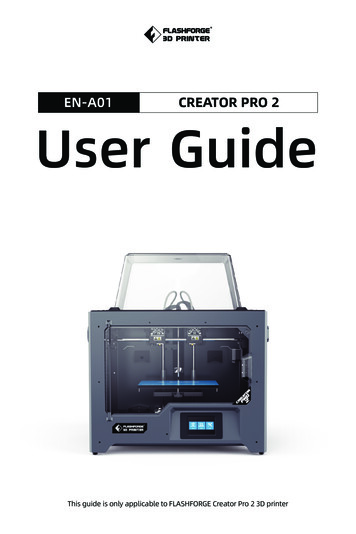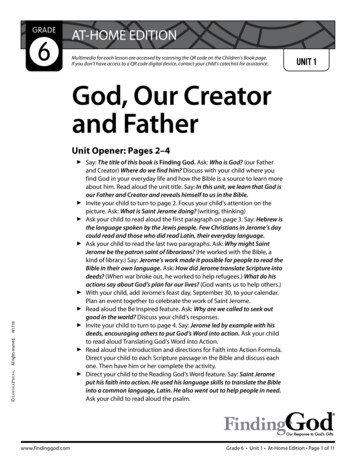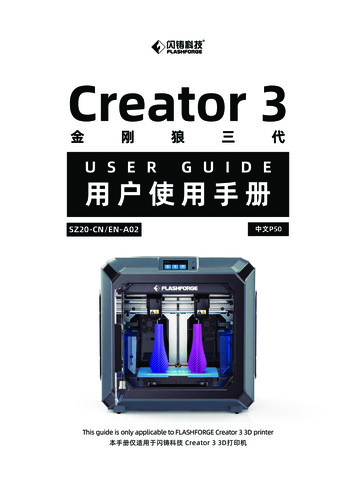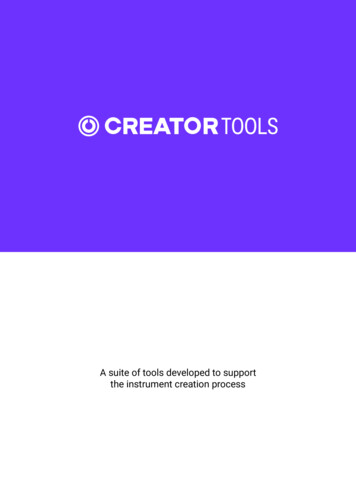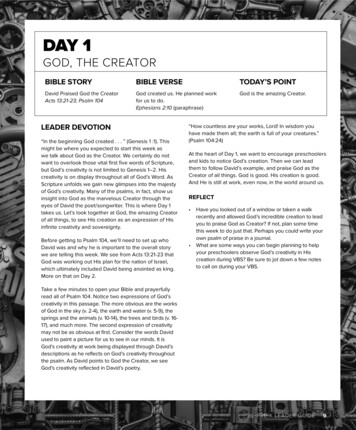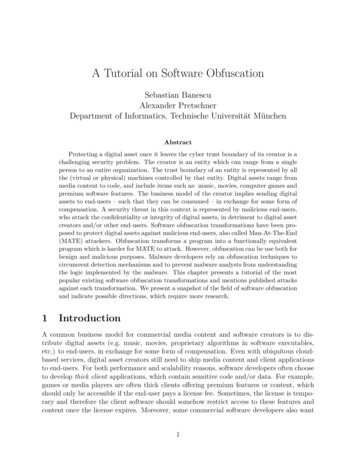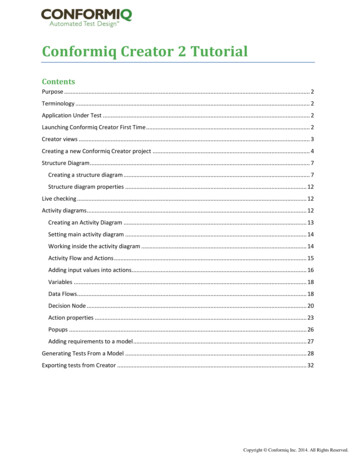
Transcription
Conformiq Creator 2 TutorialContentsPurpose . 2Terminology . 2Application Under Test . 2Launching Conformiq Creator First Time . 2Creator views . 3Creating a new Conformiq Creator project . 4Structure Diagram . 7Creating a structure diagram . 7Structure diagram properties . 12Live checking . 12Activity diagrams. 12Creating an Activity Diagram . 13Setting main activity diagram . 14Working inside the activity diagram . 14Activity Flow and Actions . 15Adding input values into actions. 16Variables . 18Data Flows. 18Decision Node . 20Action properties . 23Popups . 26Adding requirements to a model . 27Generating Tests From a Model . 28Exporting tests from Creator . 32Copyright Conformiq Inc. 2014. All Rights Reserved.
PurposeThe purpose of this document is to introduce the basics of modeling a system or application to betested. This tutorial shows the key concepts and features of Conformiq Creator and will help users to getstarted with Conformiq Creator projects.Terminology Conformiq Test Design perspective – A perspective that lets a user to generate tests, specify testcoverage goals, review, export and trace tests to coverage goals.Conformiq Modeling perspective – A perspective for creating your model.Activity Diagram – A diagram for defining activity flowsStructure Diagram – A diagram for defining interfaces available for testing a system orapplicationAction – Either a predefined Creator action or action keyword automatically generated whensaving a Structure Diagram. Actions are used in Activity Diagrams in order to express theoperation of the system or application under test.[Test] Design Configuration – Test Design Configuration is an entity in a Conformiq Creatorproject that stores test coverage goals as well as scripting backends for exporting the testsgenerated based on these goals. A Conformiq Creator project can have multiple test designconfigurations. The test coverage goals can be modified in the Conformiq Test Design view.Test Targets view– An editor in Conformiq Test Design perspective that lets user to selectcoverage targets for test generation.Scripting backend –A plugin that allows exporting the tests generated by Conformiq to a specificoutput format (for example Excel scripting backend exports generated tests into excel documentas human readable tests).Application Under TestThe application under test that is modeled in this tutorial is a simple Login page/screen. This tutorial willcapture the basic functionality of a login screen and guide the user through the process of creating amodel, generating tests and exporting the generated tests in English language, in MS Excel format formanual test execution.Launching Conformiq Creator First Time1. After the installation is complete, launch Conformiq Creator and choose a workspace directoryfor the projects.Copyright Conformiq Inc. 2014. All Rights Reserved.
2. Enter the license in Window- Preferences- Conformiq- Licensing. Enter the license key in thecorresponding place (Evaluation, Node-locked or Floating) and press OK-button.Creator viewsConformiq Creator has two views, one for modeling (Conformiq Modeling view) and one for generatingtests, reviews and exporting (Conformiq Test Design view).Conformiq Modeling viewCopyright Conformiq Inc. 2014. All Rights Reserved.
Conformiq Test Design viewCreating a new Conformiq Creator projectIn order to create a project, go to File- New- Project in the main Conformiq menu bar. This will openNew Project dialog. Expand the Conformiq folder, choose Conformiq Creator Project option and hit theNext button.Copyright Conformiq Inc. 2014. All Rights Reserved.
At this point Conformiq will show the first step of the Conformiq Creator project creation wizard. Add aname to the project, select create an empty project and hit the Next button.Now Conformiq should show step three of the Conformiq Creator project creation wizard. In this step,users have an option to choose a Test Design Configuration. For this tutorial, please use the defaultname for design configuration (DC) The name of the DC can be changed but this is not mandatory. Afterthe settings are completed, hit the Next buttonCopyright Conformiq Inc. 2014. All Rights Reserved.
Next Conformiq will show a Scripting Backend selection dialog. In this example the generated test caseswill be exported into human readable format in Excel document, hence select ExcelScripter.jar and pressthe Finnish button.At this moment the project should have been created. If so, the creator project has been createdsuccessfully. If not, repeat this chapter again.Copyright Conformiq Inc. 2014. All Rights Reserved.
Structure DiagramThe structure diagram is intended to be used for defining interfaces available for testing the givensystem or application. From all of the structure diagrams in a project, Conformiq Creator automaticallygenerates a so called action keyword repository that is used to specify the operation of the system orapplication under test in activity diagrams.The best practice for creating models is to start with structure diagrams followed by the activity diagram(model) and do this sequence of actions in small iterations generating test suites in between.Creating a structure diagramTo create a structure diagram for this tutorial: Make sure that the Conformiq Modeling perspective is selected. On the left side of the screen, navigate to the Project Explorer tab, right click on the model folderwhich is located inside the project and select New- Structure Diagram.Copyright Conformiq Inc. 2014. All Rights Reserved.
Name the structure diagram as preferred and click Finnish button. The best practice is to give astructure diagram a meaningful name. In this tutorial the structure diagram is named LoginInterfaces.A Login Interfaces structure diagram should appear in the Model folder and also the LoginInterfaces tab should appear on the canvas.Copyright Conformiq Inc. 2014. All Rights Reserved.
On the left side of the canvas, select a Palette tab. Select Screen object from the palette.Copyright Conformiq Inc. 2014. All Rights Reserved.
Once the screen is chosen, navigate the pointer to the canvas and click the left button. TheScreen object should appear. Name the Screen object as Login Screen. Select a Form object from the Palette and click on the Login Screen. A form should appear insidethe Login Screen. Note: a Form object is by default a child object hence it cannot be added tocanvas as such but must be added inside a parent object.Note: Objects can be added by three ways: Hovering the mouse over an object or canvasSelecting the object from the paletteSelecting the object from the toolbar on the topCopyright Conformiq Inc. 2014. All Rights Reserved.
Under the Form Widgets category in the Palette, select a Text Box object and add it inside theLogin form. Name the Text Box as User name. Create another Text box object. Add it inside the Login form and name the object as Password Add a Button object inside the Login form and name it as Login In the User Interface category of the Palette, select a Popup object and add it to the canvas.Name the object as Error message. Make sure to save the project frequently.Copyright Conformiq Inc. 2014. All Rights Reserved.
Structure diagram propertiesUser can set properties of an object in a Structure Diagram as well as in an Activity Diagram. TheProperties view is located on the right hand side of the canvas when in Conformiq Modeling view. Forexample, when clicking on a text box in a Structure Diagram, Conformiq allows changing properties, suchas type of the object (string, number) or status (Enable/Disable/Hidden/Don’t care).Structure propertyIf the Properties section is not visible, user should go to Window- Reset preferences- Yes. This optionwill reset the view and the Properties window should appear.Live checkingCreator analyzes automatically every diagram each time it is saved, and marks errors and warnings witha special marker (red circle or warning sign) on the object on the canvas where the problem is located.Error messages related to the markers are also listed by diagram in the Problems viewActivity diagramsActivity diagrams offer a flow chart like modeling notation which is commonly used to describe overalldesired system operation. Conformiq Creator supports a subset of standard activity diagram symbols tospecify control flows as well as data flows in activity diagrams. Activities and decision specifications haveto be enhanced with actions, conditions, and data objects to make activity diagrams suitable forautomatic test generation. Conformiq Creator uses activity- and structure models to generate anoptimum set of scenarios/tests in order to cover the applied heuristics for test case generation.Copyright Conformiq Inc. 2014. All Rights Reserved.
Creating an Activity Diagram1. In the Conformiq Modeling view, navigate and right click on the Model folder.2. Navigate New- Activity Diagram.3. Enter a new name of the diagram (optional) and hit Finnish button.Copyright Conformiq Inc. 2014. All Rights Reserved.
Setting main activity diagramIn order to generate tests from the model, Creator requires information on which activity diagram is themain activity diagram so the test generation would start from that particular activity diagram1. Right click on the activity diagram (Login Features) in the Project Explorer and select Set mainactivity diagram.Working inside the activity diagramOnce the activity diagram is created, user can start adding activity objects either from the palette, toolbar located above the canvas or by hovering over the canvas.Copyright Conformiq Inc. 2014. All Rights Reserved.
Activity Flow and Actions1. Click on the Initial node in the palette and click on the canvas in order to add the node.2. Select an Activity node, add it to the canvas and name it as Login3. Add a Control flow from the initial state to Login. In this tutorial the automatic completiondrawing is used.a. Click the initial node. An arrow should appearb. Click on the arrow and drag the control flow over the Login activity. A control flow willappear connected between the initial node and the activity.4. Hover the mouse over Login activity and Add Action iconshould appear5. Click the Add Action icon - Display Screen Action - Display ‘Login screen’ Screen6. Click the Add Action icon - User Entry Action - ‘Login screen’ Screen - Fill ‘Login form’ FormCopyright Conformiq Inc. 2014. All Rights Reserved.
7. Click the Add Action icon - User Entry Action - ‘Login screen’ Screen - ‘Login form’ Form Click ‘login’ ButtonNote: The actions (DS Display Screen, FF Fill Form, and CB Click Button) are generatedautomatically from the structure diagram.At this point an activity is created which mimics the structure diagram (Login screen and itscontent) and uses the keywords generated automatically from the structure diagram.Adding input values into actionsAt this moment the activity is created and the actions are added into the activity Next task is to add thenecessary data inside the actions in order to use it later for validation and other purposes. Once the datais added into actions, it needs to be stored into a Data Object in order to use the data later in the model.In this tutorial, two user name and password values will be added to a FF:’Login’ Form action and storedin a Variable for further usage.1. Click once on the FF: ‘Login’ Form located in the Login activity2. Locate the Properties view on the right side of the screen and double click on the InputConstraint.3. An input constraint specification popup should appear on the screen. Select [New ‘Login’ FormValue] and hit OK button.Copyright Conformiq Inc. 2014. All Rights Reserved.
The Properties tab of the Fill ‘Login’ Form should look like the picture below4. In the Properties tab, under Input Constraint ‘Login’ Form Value; enter two user name andpassword values. In this tutorial the user names will be “GoodName” and “BadName”, andpasswords will be “GoodPassword” and “BadPassword”. To add multiple values, click on the click to add alternatives and add the next value.Note: A user has also option to specify data coverage conditions. This option occurs only whenvalue lists or alternate input values are specified. The options of the data coverage are shownbelow.Copyright Conformiq Inc. 2014. All Rights Reserved.
VariablesA variable lets a user to store data values and use it across the activity model. In this tutorial, the dataadded to a Variable will be the values of the User name and Password fields that are located in the Loginform activity.1. Select a Variable from the Data Objects category in the Palette and place it on the Canvas.A window of a Variable Data Object Selection should appear. Choose Form- ’Login form’ Formand hit OK button. This means that the variable will store all the data from a specified form.2. Specify a name for Variable (optional). In this tutorial, the Variable is named as Form Storage.3. Save the project (Ctrl S)Data FlowsData flows allow user to graphically express how the data flows between the actions and data objects (inthis example, a Variable). Data flows are optional. For more information about data flows, please referto the manual.In this example, data flows are used to add values from the fields of Login form into the Form storagevariable and use the stored data later in the example.Copyright Conformiq Inc. 2014. All Rights Reserved.
1. In the Palette under the Connectors category, select Data flow connector.2. Create a connection from the FF: ‘Login’ Form action into the header of the Form Storagevariable.3. Save the project (Ctrl S)4. To check that the values of the Login form are added into the Form Storage variable, click on theLogin form and observe the Properties view; at the bottom of the window, it should read StoreResult in: data flow to ‘Form Storage’ Variable.Copyright Conformiq Inc. 2014. All Rights Reserved.
Decision NodeA decision node splits a control flow based on the evaluation of a condition. The evaluation of thecondition can only have two results:1. Condition is fulfilled (evaluates to true) - then the green Y(es) control flow is taken2. Condition is not fulfilled (evaluates to false) - then the red N(o) control flow is taken.In this example the decision diamond node will validate a given user name and password. Depending onthe values of the user name and password, the condition will be true or false. In false cases, the systemwill respond with an error popup message added earlier in a structure diagram1. Select the Decision nodefrom, add it to the canvas and add a control flow fromthe Login action to the Decision node.2. Name the decision as User ValidationCopyright Conformiq Inc. 2014. All Rights Reserved.
3. Add an Activity and name it as Invalid Login.4. Add a Control Flow form User Validation decision diamond to Invalid Login activity. Once theControl Flow from a Decision is drawn, user needs to choose which path will be associated withthe Control Flow. Choose Create False Control Flow (N).5. Add a Finalnode to the canvas and name it as Login SuccessfulCopyright Conformiq Inc. 2014. All Rights Reserved.
6. Add a Control Flow from the Decision to the Final node. Note that the Control Flow isautomatically successful. Save the project.7. After saving the project, three errors should appear in the Problems tab.In first two errors, there is no data that should be compared against anything in order to take ayes or no branch from the decision node; what is the incoming data that needs to be validatedand what should it be validated against? One of the ways of handling these scenarios is aVariable.In the third error it is stated that the Invalid login activity is empty. The reason for this is thatthere is not enough information for Creator to generate tests. An activity cannot be empty; itshould either have an action or a sub-activity.Copyright Conformiq Inc. 2014. All Rights Reserved.
Action propertiesIn Activity Diagram, the properties window us used to manage conditions and actions ie. Manage thebehavior of the system or application under test.Action propertyIf the Properties section is not visible, user should go to Window- Reset preferences- Yes. This optionwill reset the view and the Properties window should appear.1. Click on the User Validation decision node.2. Navigate on the Properties tab and notice the User Validation decision has an Equals Conditionthat has First Value and Second Value fields. This has been automatically added by Creator.NOTE: Conditions are needed for Creator decision nodes to understand when a true or false(yes/no) path should be taken. The options for different condition types can be observed bydouble clicking on the Condition icon in the Properties tab.Copyright Conformiq Inc. 2014. All Rights Reserved.
3. Drag a Data flow from the header of the Form Storage variable to the User Validation decisiondiamond. You will notice (when clicking on the decision diamond) that in the Properties view,the First Value field is now using the data from the Form Storage variable.4. Double click on the Second Value item. A value specification field should appear5. Select [New Login Form Value] and click OK button.Copyright Conformiq Inc. 2014. All Rights Reserved.
At this point, in the Properties view, the Second Value item should contain the Login Form andits text fields (User Name and Password).6. In the Value Name field, type Good Data.7. In the User name field, type GoodUser8. In the Password field, type GoodPasswordWhen generating tests, Creator will gather all data stored in the variable and compare it againstthe values that are added into the Second Value (Good data) item. If the data from the variableequals/matches Good data, Creator will create a test covering the “yes” branch. In other casesCreator will create a test case covering the “no” branch.Copyright Conformiq Inc. 2014. All Rights Reserved.
PopupsPopups are used to describe the popup windows on the real application. This tutorial shows a way tohandles error scenarios by using a popup to show an error message to the user if the user name andpassword combinations do not match.1. Select the Invalid login activity and then click on the actionbutton2. Add an action: Display Popup Action - Display Error message Popup. Click OK button.A DP: ‘Error message’ Popup action should appear in the Invalid login activity.3. Click on the DP: ‘Error message’ Popup action and double click Popup Contents item in theProperties viewA Popup content specification window will appear.4. Select [New ‘Error message’ Popup Value] and click OK buttonCopyright Conformiq Inc. 2014. All Rights Reserved.
5. In the Properties window, enter the error text in the ‘Error message’ Text field. In this tutorialthe added text is “Wrong user name or password. Please try again”.Adding requirements to a modelIn Creator, requirements may be added inside an activity. Once the requirements are added to themodel (activity diagram) they become targets for test generation. Also, a traceability matrix betweenthe requirements and generated tests will be created automatically.In this tutorial the requirement will be added as written in a specification. The requirement name is “Thewill system should show an error message if the login is incorrect”. In order to fulfill the requirement, anerror handling logic be described in the activity diagram.1. Select the Invalid Login activity and click on the actionbutton.2. Select Requirement Action from the action selector and press OK button.3. In the Properties view, add in the Requirement Identifier - “The system should show an errormessage if the login is incorrect” and save the project.Copyright Conformiq Inc. 2014. All Rights Reserved.
4. Draw a control flow from the Invalid Login activity to the Login activity and save the project.Generating Tests From a ModelAfter the model is created, user needs to upload the model to Conformiq Computation Server and applythe Testing Goals to the engine in order to get the needed tests generated. Besides test generation,Conformiq will generate a coverage report that will show what parts of the model have been covered aswell as how tests are linked to the requirements that have been added in the model. Conformiq will alsoshow how each test is exercising the model.1. Change the view to a Conformiq Test Design perspective.2. Press Load Model button under the Progress view.Copyright Conformiq Inc. 2014. All Rights Reserved.
3. Press Generate test cases button.The tests will be generated and shown in the Test Cases view.As it can be observed on the right side of the picture above, the Model Browser shows that theno branch of the User Validation decision diamond has not been covered, hence the path alongwith the Invalid Login activity has being marked in red. This usually means that either there issomething wrong with the model or that Conformiq Creator needs higher lookahead depth. Formore information on lookahead depth, please refer to the Conformiq Creator user manual.4. Select (click) the project folderCopyright Conformiq Inc. 2014. All Rights Reserved.
5. Navigate to Project- Properties- Conformiq Options, insert a Lookahead Depth value to 3 andclick OK button.6. Repeat step 3 (Press Generate test cases button).7. Once the tests are generated, in the Test Targets view, expand the “Requirements” section andexpand the requirement itself. It can be seen that the requirement is covered by a test number 3.Copyright Conformiq Inc. 2014. All Rights Reserved.
8. In the Test Targets view, click on the column number 1 (i.e. the first test case). The test will beselected and shown as message sequence diagram. The model browser will show how the test isexercising the model.9. In order to review tests and data generated in the test, double click on the test step/arrow inthe test step view. The input/output values generated on the particular test step, will be shownon the right side of the test step view. Also the model browser will highlight the action/activitythat is exercised at the particular test step.Copyright Conformiq Inc. 2014. All Rights Reserved.
Exporting tests from CreatorThe generated tests can be exported into various formats for manual or automated test execution. Thegenerated test suit can also be uploaded to an ALM/test management system. In this tutorial, tests areexported into Excel spread sheet in human readable format (English).1. In Progress Panel, click Export test cases button.2. Right click on thelink in the Project Explorer and select Open With - SystemEditor. The test cases will be displayed in Excel in English language.3. Once the test suite has been opened in Excel, click on the Test cases tab in order to view the teststeps.Copyright Conformiq Inc. 2014. All Rights Reserved.
Action – Either a predefined Creator action or action keyword automatically generated when saving a Structure Diagram. Actions are used in Activity Diagrams in order to express the operation of the system or application under test. [Test] Design Configuration – Test
